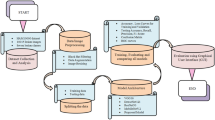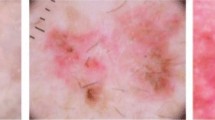Abstract
There are various types of skin lesions which are highly indistinguishable by naked eyes, but some may be malignant others may be benign. Early and rapid determination of these lesions enables dermatologists to treat the sufferers and save their lives. The paper discusses a solution for this problem using deep learning algorithms and deploys it on a web application. The users of the system need to upload a dermoscopic image of the affected area, and the convolutional neural network model will return whether the image is benign or malignant and also will tell the user the severity based on further classification. The surface layer classification model of whether the image is benign or malignant is trained using International Skin Imaging Collaboration (ISIC) 2020 data set, and the further classification model which tells about the severity is trained using ISIC 2019 data set. After various empirical studies, DenseNet121 architecture proved out to be best giving the accuracy of about 89.2% on binary classification, and ResNet50 architecture gave the best results when it came to the multi-class classification with the accuracy of about 93.87%. Both of these models are deployed onto the website for automated real-time usage.
Access this chapter
Tax calculation will be finalised at checkout
Purchases are for personal use only
Similar content being viewed by others
References
Kassem MA, Hosny KM, Fouad MM (2020) Skin lesions classification into eight classes for ISIC 2019 using deep convolutional neural network and transfer learning. IEEE Access 8:114822–114832
Arshad M et al (2021) A computer-aided diagnosis system using deep learning for multi-class skin lesion classification. Comput Intell Neurosci 2021
Hasan MR et al (2021) Comparative analysis of skin cancer (Benign vs. Malignant) detection using convolutional neural networks. J Healthcare Eng 2021
Estava A et al (2017) Dermatologist level classification of skin cancer with deep neural networks. Nature 542(7639):115–118
Alom MZ et al (2019) Skin cancer segmentation and classification with NABLA-N and inception recurrent residual convolutional networks. arXiv:1904.11126 (2019)
Hassan HA et al (2019) Skin lesion classification using deep learning techniques
Cullell-Dalmau M et al (2021) Convolutional neural network for skin lesion classification: understanding the fundamentals through hands-on learning. Front Med 8:213
Wu J et al (2020) Skin lesion classification using densely connected convolutional networks with attention residual learning. Sensors 20(24):7080
Kadampur MA, Al Riyaee S (2020) Skin cancer detection: applying a deep learning based model driven architecture in the cloud for classifying dermal cell images. Inf Med Unlocked 18:100282
Dutta A, Hasan K, Ahmad M (2021) Skin lesion classification using convolutional neural networks for melanoma recognition. In: Proceedings of international joint conference on advances in computational intelligence. Springer, Singapore
Albahar MA (2019) Skin lesion classification using convolutional neural network with novel regularizer. IEEE Access 7:38306–38313
Wang S, Hamian M (2021) Skin cancer detection based on extreme learning machine and a developed version of thermal exchange optimization. Comput Intell Neurosci 2021
Ali MS et al (2021) An enhanced technique of skin cancer classification using deep convolutional neural networks with transfer learning models. Mach Learn Appl 5:100036
Gessert N et al (2020) Skin lesion classification using ensembles of multi-resolution EfficientNets with metadata. MethodsX 7:100864
Abuzaghleh O, Barkana BD, Faezipour M (2015) Noninvasive real-time automated skin lesion analysis system for melanoma early detection and prevention. IEEE J Transl Eng Health Med 3:1–12
Chaturvedi SS, Gupta K, Prasad PS (2020) Skin lesion analyser: an efficient seven-way multi-class skin cancer classification using MobileNet. In: International conference on advanced machine learning technologies and applications. Springer, Singapore
Moldovan D (2019) Transfer learning based method for two-step skin cancer images classification. In: E-health and bioengineering conference (EHB). IEEE
The International Skin Imaging Collaboration (ISIC) Accessed: 22 Dec 2018 [Online]. Available: https://www.isicarchive.com/#!/topWithHeader/onlyHeaderTop/gallery
Codella NCF, Gutman D, Celebi ME, Helba B, Marchetti MA, Dusza SW, Kalloo A, Liopyris K, Mishra N, Kittler H, Halpern A (2017) Skin lesion analysis toward melanoma detection: a challenge at the 2017 international symposium on biomedical imaging (ISBI), hosted by the international skin imaging collaboration (ISIC). arXiv:1710.05006
Combalia M et al (2019) Bcn20000: dermoscopic lesions in the wild. arXiv preprint arXiv:1908.02288
Rotemberg V et al (2021) A patient-centric dataset of images and metadata for identifying melanomas using clinical context. Sci Data 8(1):1–8
ImageDataGenerator API: https://www.tensorflow.org/api_docs/python/tf/keras/preprocessing/image/ImageDataGenerator
FAST AI official documentation [Online]. https://www.fast.ai/
SIIM-ISIC Melanoma Classification-ISIC 2020 challenge on Kaggle. https://www.kaggle.com/c/siim-isic-melanoma-classification
Codella N, Rotemberg V, Tschandl P, Emre Celebi M, Dusza S, Gutman D, Helba B, Kalloo A, Liopyris K, Marchetti M, Kittler H, Halpern A (2018) Skin lesion analysis toward melanoma detection 2018: a challenge hosted by the international skin imaging collaboration (ISIC). https://arxiv.org/abs/1902.03368
Akram T et al (2020) A multilevel features selection framework for skin lesion classification. Human-Centric Comput Inf Sci 10(1):1–26
FastAPI Documentation. https://fastapi.tiangolo.com/
Javascript Documentation. https://developer.mozilla.org/en-US/docs/Web/JavaScript
Author information
Authors and Affiliations
Corresponding author
Editor information
Editors and Affiliations
Rights and permissions
Copyright information
© 2023 The Author(s), under exclusive license to Springer Nature Singapore Pte Ltd.
About this paper
Cite this paper
Singh, A., Bera, S., Chaturvedi, P., Gadhave, P., Lifna, C.S. (2023). DermoCare.AI: A Skin Lesion Detection System Using Deep Learning Concepts. In: Jacob, I.J., Kolandapalayam Shanmugam, S., Izonin, I. (eds) Data Intelligence and Cognitive Informatics. Algorithms for Intelligent Systems. Springer, Singapore. https://doi.org/10.1007/978-981-19-6004-8_4
Download citation
DOI: https://doi.org/10.1007/978-981-19-6004-8_4
Published:
Publisher Name: Springer, Singapore
Print ISBN: 978-981-19-6003-1
Online ISBN: 978-981-19-6004-8
eBook Packages: Intelligent Technologies and RoboticsIntelligent Technologies and Robotics (R0)




